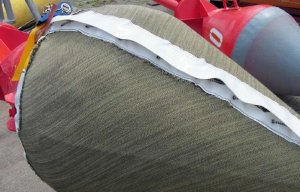
Cellulose and basalt innovations at Techtextil
Ionic liquids have gained interest as green alternatives for organic solvents in different processes.

12th October 2022
Innovation in Textiles
|
Stockholm, Sweden
The 2022 Marcus Wallenberg Prize of SEK 2 million (approximately €182,000) has been awarded to Professors Ilkka Kilpeläinen and Herbert Sixta for the development of novel ionic liquids to process wood biomass into high-performance textile fibres.
King Carl XVI Gustaf presented the prize on Monday 10 October in Stockholm.
The future demand for textile fibres is growing due to global population growth and the production of cotton – the predominantly used cellulose fibre for textiles – is not expected to keep up with the demand. Man-made cellulose fibres are an excellent complement with similar properties.
The main processes to produce man-made cellulose textile fibres are the viscose process, where cellulose is solubilized using alkali and carbon disulphide, and the Lyocell process, where N-methylmorpholine-N-oxide (NMMO) is used to dissolve cellulose. The viscose process has, however, become environmentally controversial due to the use of toxic carbon disulphide as the main reagent. The Lyocell process on the other hand, is restricted by the instability of the NMMO.
These challenges have led to extensive research on different solvent systems for cellulose to produce regenerated cellulose fibres. Ionic liquids have gained interest as green alternatives for organic solvents in different processes. They are salts that can be melted below 100°C and have unique properties including low vapour pressure, high thermal stability and high dissolving capability of different organic and inorganic substances.
Man-made cellulose fibres from wood with high technical quality have been developed by two research teams in Finland, at the University of Helsinki and Aalto University. In this concept, the design and use of novel superbase ionic liquids to process wood pulp into high-performance textile fibres was developed and currently tested for scaling-up. The team led by Professor Kilpeläinen at the University of Helsinki developed superbase ionic liquid solvents for dissolution of wood biomass e.g. bleached or unbleached pulp or recycled cellulose pulp. Professor Sixta and his team at Aalto University developed the ionic liquid-based fibre shaping process based on dry-jet wet spinning.
“This unique collaboration has resulted in novel sustainable concept of textile fibre production from wood,” said Johanna Buchert, chairperson of the Marcus Wallenberg Prize selection committee. “The innovation is expected to result in a large range of new product and business opportunities for the forest industry.”
The Marcus Wallenberg Prize is an international prize with the purpose of recognising, encouraging and stimulating pathbreaking scientific achievements which contribute significantly to broadening knowledge and to technical development within the fields of importance to forestry and forest industries.

Business intelligence for the fibre, textiles and apparel industries: technologies, innovations, markets, investments, trade policy, sourcing, strategy...
Find out more